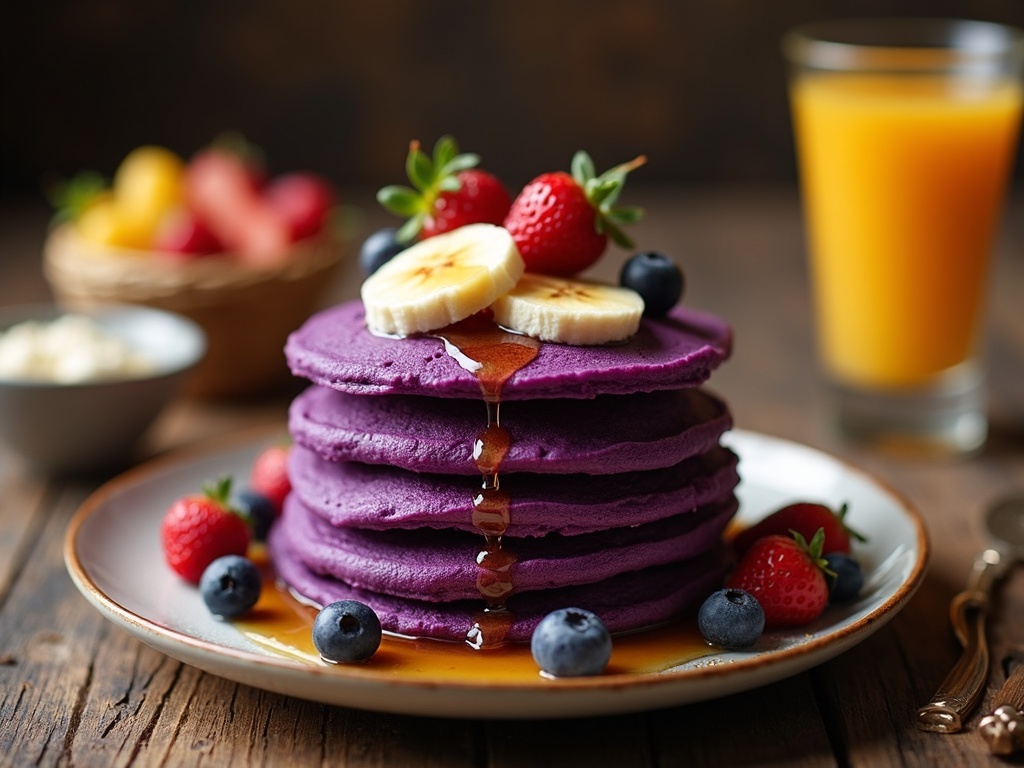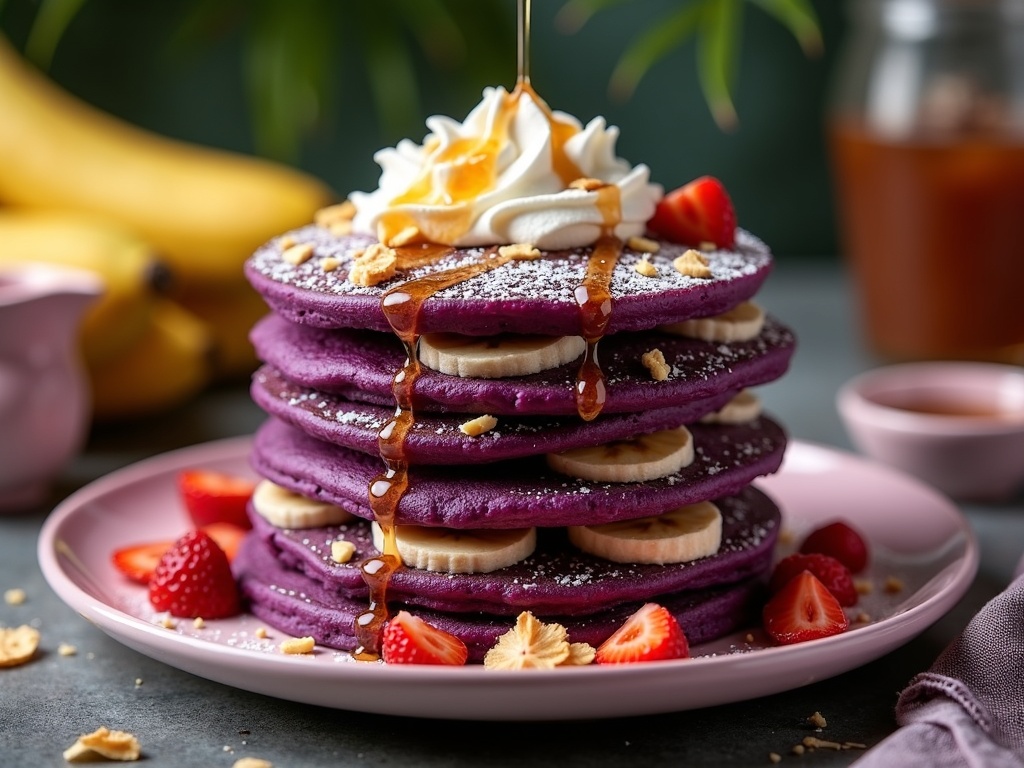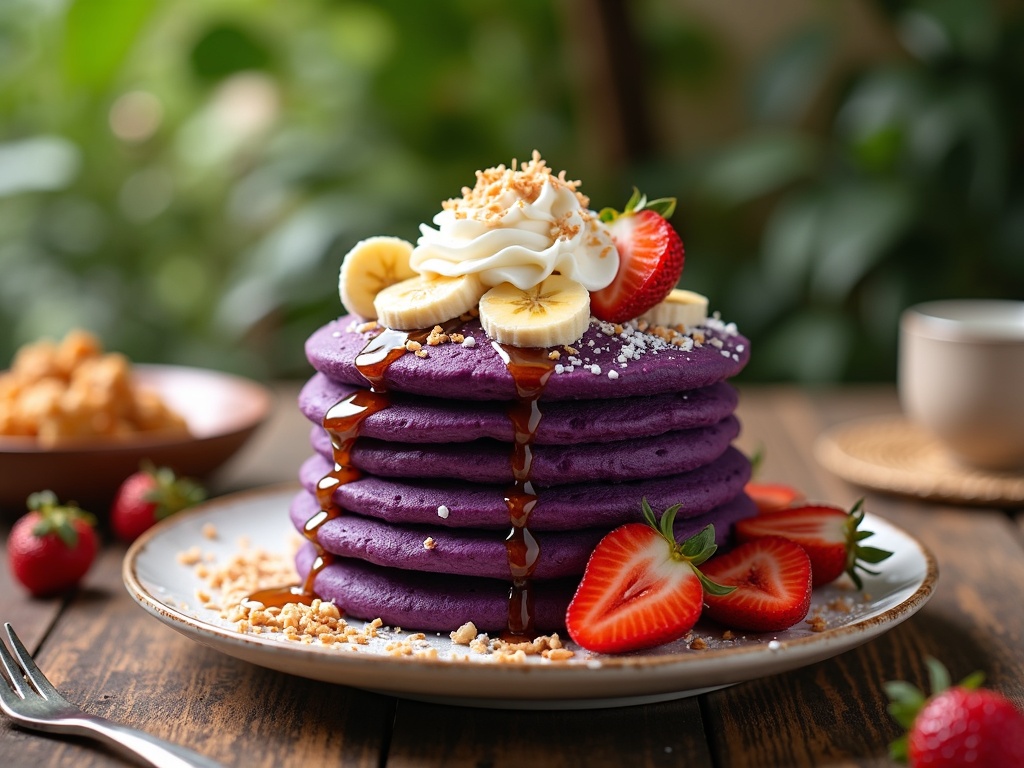Ube mochi pancakes represent a delicious fusion of Filipino purple yam and Japanese glutinous rice flour that has transformed the brunch scene with their vibrant color and uniquely chewy texture. This culinary creation combines nutritional benefits with photo-worthy aesthetics, satisfying both health-conscious diners and those looking for exciting flavor experiences beyond traditional breakfast options.
Find In This Article
Key Takeaways
- The distinctive purple hue comes naturally from ube (purple yam), which contains antioxidants, vitamins, and minimal fat, making these pancakes a healthier breakfast alternative.
- The combination of ube’s subtle sweetness and mochi flour’s chewy texture creates a satisfying eating experience that has contributed to their viral popularity on social media.
- Making perfect ube mochi pancakes requires quality ingredients, proper mixing technique, and cooking at the right temperature to achieve the ideal balance of fluffiness and chewiness.
- These pancakes are highly customizable with various toppings like coconut whipped cream, fresh fruits, honey, and toasted coconut flakes to enhance their flavor profile.
- This breakfast innovation represents cultural fusion at its finest, bringing together Filipino and Japanese culinary traditions while appealing to modern diners seeking diverse, photogenic food experiences.
Why Ube Mochi Pancakes Are Taking Over Brunch
The fusion of Filipino ube and Japanese mochi has created a breakfast sensation that’s impossible to ignore. These vibrant purple pancakes with their chewy texture have transformed the brunch scene across the country. I’ve noticed that Asian-inspired breakfast options have surged in popularity, with data showing a 30% increase in Asian cuisine popularity in Western markets over the past 5 years.
The Perfect Cultural Culinary Storm
Ube mochi pancakes represent more than just a tasty meal – they’re at the intersection of cultural appreciation and culinary innovation. The striking purple color from ube (purple yam) creates an instantly Instagram-worthy dish, while the chewy texture from mochi flour gives these pancakes their signature bounce. This combination has proven irresistible to brunch enthusiasts looking for something beyond traditional pancake recipes and familiar breakfast foods.
Market analysts project a 5% annual growth for ube-based products, reflecting consumers’ increasing appetite for diverse flavors. This trend aligns perfectly with the expanding brunch market, which is expected to reach $200 billion by 2025 in the U.S. alone.
Social media has played a crucial role in the meteoric rise of these purple pancakes. Hashtags like #UbePancakes and #MochiPancakes have helped create viral moments that introduce these delicious creations to new audiences daily. The visual appeal can’t be understated – the natural purple hue requires no artificial coloring, making them appealing to health-conscious diners as well.
What makes these pancakes particularly special is their ability to satisfy multiple cravings at once:
- The subtle sweetness of ube that isn’t overwhelming
- The satisfying chew from mochi flour that makes each bite memorable
- The natural vibrant color that brightens any breakfast table
- The cultural significance that connects diners to Filipino and Japanese culinary traditions
I’ve found that even breakfast purists who typically stick to eggs and toast are being won over by the unique texture and flavor profile of these purple pancakes.
The Power-Packed Purple Superfood
Ube, the vibrant purple yam from the Philippines, isn’t just stunning on your plate – it’s packed with nutrients that make these pancakes a healthier breakfast option. I’ve found that incorporating this root vegetable into my morning routine adds both flavor and nutritional benefits that regular pancakes simply can’t match.
Nutritional Breakdown of Ube
The deep purple color of ube isn’t just for show – it indicates the presence of powerful antioxidants that help fight inflammation and cellular damage. A 100g serving of ube delivers approximately 140 calories, with minimal fat content at just 0.2g. This makes it an excellent base for a satisfying breakfast that won’t weigh you down.
Carbohydrates in ube clock in at around 37g per 100g serving, providing sustained energy throughout your morning. While the protein content is modest at 2g, combining ube with eggs in your pancake batter creates a more complete protein profile. The dietary fiber in ube supports digestive health and helps you feel fuller longer.
Ube also contains impressive amounts of essential vitamins. It’s particularly rich in Vitamin C, boosting your immune system right at breakfast time. The Vitamin A content contributes to eye health and skin maintenance – benefits you might not expect from your typical pancake stack.
When paired with mochi rice flour, these pancakes gain additional nutritional density. Mochi provides about 220 calories per 100g serving, adding a chewy texture and satisfying mouthfeel to your breakfast. I’ve noticed the combination creates pancakes that keep hunger at bay much longer than traditional varieties.
For those with dietary restrictions, ube mochi pancakes can easily accommodate your needs. Gluten-free options are readily available by using alternative flours like rice flour or tapioca starch instead of wheat-based ingredients. This versatility makes these purple pancakes accessible to almost everyone.
The nutritional benefits of ube explain why it’s been a staple in Filipino cuisine for generations. Now, this traditional ingredient is gaining well-deserved global recognition as both chefs and home cooks discover its unique properties. The rise in popularity of ube has coincided with increased interest in functional foods – ingredients that offer health benefits beyond basic nutrition.
I’ve experimented with various pancake recipes over the years, and ube mochi pancakes stand out for their perfect balance of nutrition and indulgence. If you’re looking to try making them yourself, start with a basic pancake recipe and adapt it with ube and mochi flour.
The natural sweetness of ube means you can often reduce added sugar in your pancake batter. I typically use about half the sugar called for in standard recipes, allowing the earthy-sweet flavor of the purple yam to shine through. This makes ube mochi pancakes a smarter choice for those monitoring their sugar intake.
Beyond their impressive nutritional profile, these pancakes offer practical cooking benefits. The starch content in both ube and mochi flour creates a naturally fluffy texture, reducing the need for chemical leavening agents. The vibrant color also means you’re getting a visually striking breakfast without artificial food coloring.
As more people discover the wonders of this purple superfood, innovative recipes continue to emerge. From weekend brunch showstoppers to grab-and-go breakfast options, ube mochi pancakes represent the perfect fusion of traditional ingredients and modern nutritional awareness.

Create Perfect Ube Mochi Pancakes at Home
Ube mochi pancakes combine the vibrant purple color of ube (purple yam) with the chewy texture of mochi for a breakfast treat that’s both visually stunning and delicious. I’ve perfected this recipe through countless weekend mornings, finding the right balance of ingredients for that ideal texture – fluffy yet satisfyingly chewy.
The Perfect Ube Mochi Pancake Batter
The key to outstanding ube mochi pancakes lies in the quality of your ingredients and the mixing technique. For this recipe, you’ll need:
- 1 cup of ube (mashed or pureed)
- 1 cup glutinous rice flour
- 1/4 cup sugar
- 1 teaspoon baking powder
- 1 cup milk
Start by mixing all the dry ingredients together in a large bowl – the glutinous rice flour, sugar, and baking powder. This ensures even distribution of the leavening agent. In a separate bowl, combine the mashed ube and milk until smooth. Then pour the wet ingredients into the dry mixture, stirring just until combined. The batter should be thick but pourable, with a gorgeous purple hue.
Don’t overmix the batter as this can make your pancakes tough rather than tender. A few small lumps are perfectly fine and will disappear during cooking. If you find the batter too thick, add a tablespoon of milk at a time until you reach the right consistency.
Cooking Techniques for Perfect Results
The cooking process is just as important as the ingredients when making ube mochi pancakes. Here’s how to get them right every time:
- Preheat your pan or griddle over low-medium heat. This is critical – too high heat will burn the outside while leaving the inside raw. I always test with a small drop of batter first to check if the temperature is right.
- Pour about 1/4 cup of batter for each pancake, allowing space between them for easy flipping. Cook for 2-3 minutes on the first side, watching for bubbles to form on the surface and for the edges to look set. This is your signal that it’s time to flip.
- After flipping, cook for another 2-3 minutes until the second side is golden brown. The pancakes should rise slightly and have a springy feel when gently pressed in the center. If you’re making a large batch, you can keep your pancakes warm in a low oven while cooking the remaining batter.
The unique combination of glutinous rice flour and ube creates a distinctive texture – slightly chewy from the mochi element, but still light and fluffy from the baking powder. The natural sweetness of ube pairs beautifully with the added sugar, though you can adjust this to taste.
These pancakes are best served fresh off the griddle, though the batter can be made ahead and refrigerated overnight. Top with a drizzle of coconut syrup, a dollop of whipped cream, or a sprinkle of toasted coconut for an authentic touch.
The distinctive purple color makes these pancakes particularly appealing for special breakfasts or brunches. Kids especially love the vibrant color, and you can feel good knowing they’re enjoying the nutritional benefits of ube, which is rich in vitamins and antioxidants.
Customize Your Purple Paradise
I’ve found that the deep purple canvas of ube mochi pancakes creates the perfect backdrop for a variety of flavors and toppings. The chewy, slightly sweet base can be enhanced in countless ways to suit your taste preferences.
Flavor Variations
Adding a splash of coconut milk to your ube mochi pancake batter introduces a tropical dimension that pairs perfectly with the purple yam flavor. For a more traditional approach, a teaspoon of vanilla extract can balance the earthiness of the ube while amplifying its natural sweetness. These simple additions transform the base recipe without compromising the distinctive texture that makes mochi pancakes so uniquely satisfying.
The beauty of these purple pancakes lies in their versatility – they can be adapted for different occasions, from a simple breakfast to an impressive brunch centerpiece.
Topping Ideas
The finishing touches make all the difference when serving ube mochi pancakes. Food trend data shows that 67% of food enthusiasts enjoy experimenting with different toppings, while 45% prefer lighter, fruit-based additions.
Here are some tried-and-tested options to elevate your purple stack:
- Coconut whipped cream – the light, airy texture creates a beautiful contrast against the chewy pancakes
- Fresh fruit pairings – bananas and strawberries offer complementary flavors that enhance the ube
- Drizzles of honey – for natural sweetness that doesn’t overpower the delicate ube flavor
- Toasted coconut flakes – adding a pleasant crunch and tropical notes
- Sesame seeds – providing nutty undertones and visual interest
I’ve discovered that layering these pancakes with sliced bananas between each one creates a stunning presentation while ensuring every bite contains the perfect balance of flavors. Strawberries, with their slight tartness, cut through the richness of the ube and provide a beautiful color contrast against the purple backdrop.
For special occasions, a light dusting of powdered sugar or a small pitcher of maple syrup served alongside gives guests options to customize their own purple paradise. The versatility of these pancakes makes them suitable for both sweet-tooth satisfaction and those who prefer a more subtle flavor profile.

Cultural Fusion on Your Plate
I’ve noticed that ube mochi pancakes perfectly capture the magic that happens when culinary traditions collide. This breakfast delight brings together distinct Asian flavors and textures to create something entirely new and exciting.
East Asian Culinary Heritage
Ube, a vibrant purple yam native to the Philippines, brings its distinctive nutty, vanilla-like flavor to these pancakes. Far more than just a pretty color, ube has been a staple in Filipino cuisine for generations, appearing in everything from desserts to savory dishes. Its natural sweetness and earthy undertones make it a perfect candidate for breakfast innovations.
The mochi component comes from Japanese culinary tradition, where glutinous rice flour (mochiko) creates that signature chewy, stretchy texture that’s become increasingly popular in Western desserts. When incorporated into pancake batter, it transforms ordinary flapjacks into something with delightful elasticity and bite.
Modern Food Evolution
These purple pancakes represent more than just a tasty breakfast—they’re evidence of our increasingly connected food culture. I’ve seen ube mochi pancakes popping up on menus at specialty cafes across major cities, often garnering lines of eager customers waiting to snap the perfect photo of their stack.
The appeal extends beyond just aesthetics. These pancakes connect with health-conscious eaters looking for:
- Natural ingredients with cultural significance
- Complex carbohydrates from the yam component
- Unique flavor profiles beyond typical Western breakfast options
- Gluten-free alternatives (when made with rice flour alone)
- Plant-based protein options when paired with appropriate toppings
This fusion creation demonstrates how traditional ingredients can find new life in contemporary kitchens. The purple stacks have become particularly popular with brunch enthusiasts who want something beyond traditional pancake recipes while still enjoying familiar breakfast comfort.
The vivid color comes naturally from the ube itself, appealing to those seeking to avoid artificial dyes while still enjoying Instagram-worthy food. Specialty cafes have capitalized on this, creating signature versions topped with coconut cream, fresh fruit, and even ube sauce for an extra purple punch.
As global palates become more adventurous, these cross-cultural creations showcase how food continues to evolve, bringing distant culinary traditions together on a single plate.
Sources:
Tasty and Trendy: The Rise of Ube in Modern Cuisine
Market Research Today
Culinary Wellness Journal
Food Culture and Society

